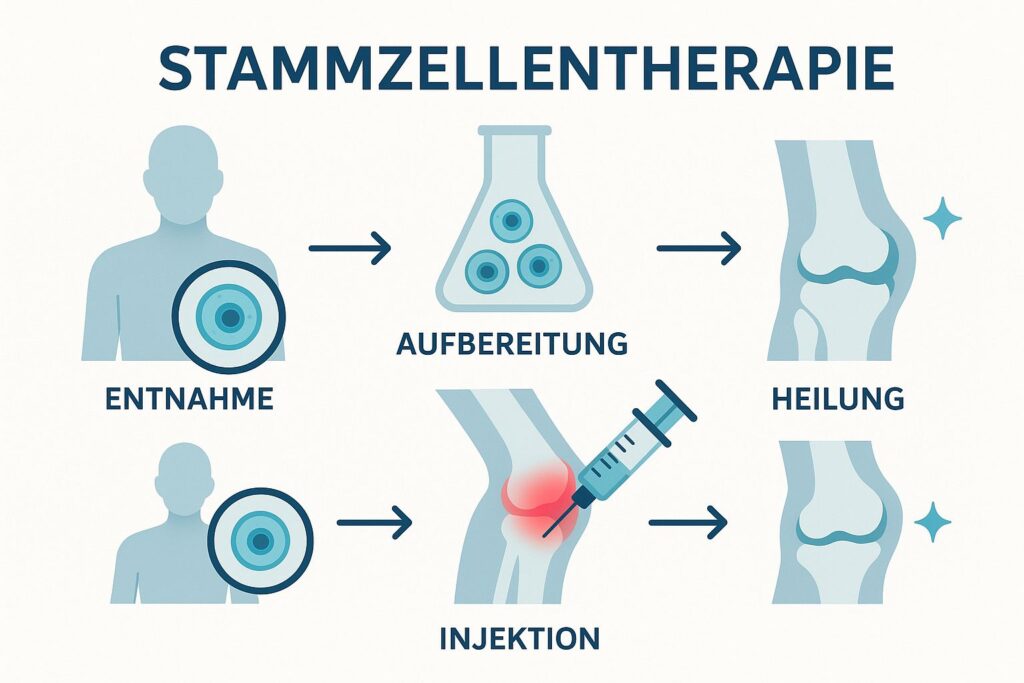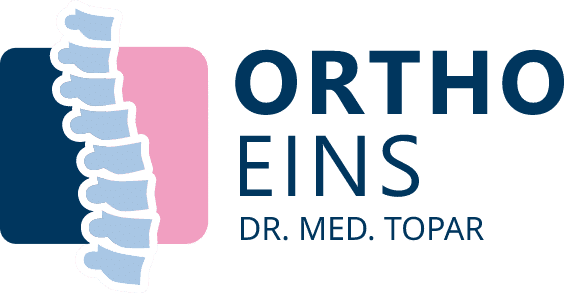Stem cell therapy
in Berlin
What is stem cell therapy?
Stem cell therapy is one of the modern methods of regenerative medicine. It utilizes the ability of certain of the body’s own cells to repair damaged tissue and stimulate healing processes.
In orthopedics, the primary focus is on the regeneration of joint, cartilage, tendon, and connective tissue. The goal of treatment is to relieve pain, improve mobility, and slow progressive wear and tear.
In contrast to purely symptom-oriented therapies, stem cell therapy follows an approach that aims to support the body’s own regeneration mechanisms.

How does the therapy work?
How does the therapy work?
The treatment begins with the extraction of stem cells, which are usually taken from the patient’s own fat or bone marrow.
After careful processing, in which the stem cell-containing components are isolated and tested for quality, the cells can be injected directly into the affected joint or tissue. This allows them to reach the site of damage, where their biological properties trigger regenerative processes.
In some cases, therapy takes place in several steps and is accompanied by physiotherapy measures to further promote healing.
Areas of application in orthopedics
Areas of application in orthopedics
In orthopedic practice, stem cell therapy is primarily used for degenerative joint diseases, early stages of osteoarthritis, or cartilage damage . Tendon and ligament injuries, as well as certain chronic musculoskeletal disorders, can also benefit from the procedure.
The aim is to support damaged tissue and specifically stimulate the body’s self-healing powers, so that symptoms are alleviated and the function of the affected area is improved.
Scientific status and evidence
Scientific status and evidence
Stem cell therapy has been intensively researched for several years. Numerous studies show that the use of autologous stem cells has a good safety profile and can lead to symptom improvement in many patients. Initial controlled data are now available, particularly for osteoarthritis of the knee, suggesting positive effects on pain and mobility.
Nevertheless, the procedure is still considered innovative in Germany and, in many areas, still experimental. Many questions, such as the optimal cell quantity, the ideal source of stem cells, or the durability of the effects, are currently being scientifically investigated.
Benefits and risks
Benefits and risks
A major advantage of stem cell therapy is that it utilizes the body’s own regenerative processes, thus having the potential to actually repair tissue. This can reduce pain and improve mobility.
Since the cells are harvested from the patient’s own body, the risk of rejection is extremely low. At the same time, patients must be aware that this is a relatively new procedure, and its long-term effects have not yet been fully researched.
Not all cases experience noticeable improvement, and in cases of advanced wear, treatment often does not replace joint replacement. Possible side effects such as infections or local irritation are rare but can occur.
Who is suitable?
Who is suitable?
The therapy is particularly suitable for people suffering from chronic joint pain and for whom conservative measures such as physiotherapy or drug-based pain management have not been sufficiently effective. Patients with cartilage defects or early-stage osteoarthritis can also benefit if they are in good general health.
Treatment is less effective in cases of advanced joint destruction, severe systemic diseases, or acute infections. Whether stem cell therapy is advisable in an individual case will be determined during a detailed examination and consultation.
Procedure of a treatment in our practice
Procedure of a treatment in our practice
The initial phase involves a detailed consultation, including examination and imaging to accurately assess the individual situation. Once the treatment has been decided upon, the stem cells, usually from adipose tissue or bone marrow, are harvested under local anesthesia.
The cells are then processed and injected directly into the affected joint or tissue. After treatment, a short recovery period is recommended before gradually resuming targeted exercise. Regular follow-up examinations are performed to monitor the progress and support ongoing therapy.
Frequently Asked Questions (FAQ)
Is the treatment painful?
Is the treatment painful?
The stem cells are harvested under local anesthesia and are well tolerated by most patients. The injection into the affected joint is also generally perceived as minimally stressful.
When will the first results be noticeable?
When will the first results be noticeable?
Initial improvements often occur within a few weeks. However, the full effect often takes several months to develop and depends on the individual clinical picture.
How long does the effect last?
How long does the effect last?
Many patients report positive effects lasting one to three years. However, the duration of the effect varies from individual to individual, and repeating the treatment may be beneficial in certain cases.
Are there any risks or side effects?
Are there any risks or side effects?
The procedure is generally considered safe. However, in rare cases, infections, local irritation, or pain at the donor site can occur. We will inform you in detail about all possible risks beforehand.
Will the costs be covered by health insurance?
Will the costs be covered by health insurance?
In most cases, this is a self-pay service, as stem cell therapy is not yet part of the regular benefits package of statutory health insurance providers. However, partial coverage by private insurers is possible and will be reviewed on a case-by-case basis.
What alternatives are there?
What alternatives are there?
Proven treatment options include physiotherapy, drug-based pain therapy, injections with hyaluronic acid or autologous blood, and surgical interventions, including joint replacement in cases of advanced osteoarthritis.


